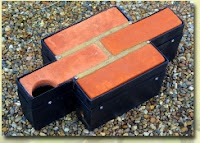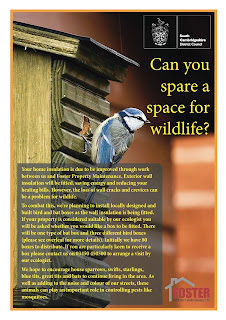Written by Dick
Accommodation for Swifts built in to buildings is to be preferred to accommodation retrofitted on the outside. Planning departments are now conditioning new developments and renovations to provide space for wildlife in the interests of biodiversity: bats, House Sparrows, Starlings and Swifts. We have produced a downloadable pdf with all of the Swift bricks that we have found so far, with pictures, a table of dimensions and approximate prices. This has now been taken on by the RSPB and Swift-Conservation as a good way to promote Swift Bricks.
Here are a few examples to whet your appetite:
Birdbrickhouses
This is a box designed so that the replaceable front can be matched with any existing brickwork. We reviewed it here
.jpg)
CJ Wildlife Woodstone
This is one of 3 models that CJ Woodstone supply, the others you can see on their website. The one illustrated here is the 90068.
Ecosurv
The front can be custom made to match any bricks. There is another version with the entrance 1 brick lower.
Ibstock
An attractive brick, designed to encroach minimally on the cavity. We have an account of an early success here.
Schwegler
Perhaps the oldest established company in the Swift brick business. There are a number of designs in their catalogue, including the Cavity Panel. Schwegler boxes have been very successful for Swifts.
The one illustrated here is the 16S.
Hanson clay air brick liner
The model 401 makes an attractive, low cost Swift brick. We wrote up how to make and install it here, and Swifts seem to like it.
(Scroll to page 9 on the PDF)
Accommodation for Swifts built in to buildings is to be preferred to accommodation retrofitted on the outside. Planning departments are now conditioning new developments and renovations to provide space for wildlife in the interests of biodiversity: bats, House Sparrows, Starlings and Swifts. We have produced a downloadable pdf with all of the Swift bricks that we have found so far, with pictures, a table of dimensions and approximate prices. This has now been taken on by the RSPB and Swift-Conservation as a good way to promote Swift Bricks.
Here are a few examples to whet your appetite:
Birdbrickhouses
This is a box designed so that the replaceable front can be matched with any existing brickwork. We reviewed it here
.jpg)
CJ Wildlife Woodstone
This is one of 3 models that CJ Woodstone supply, the others you can see on their website. The one illustrated here is the 90068.
Ecosurv
The front can be custom made to match any bricks. There is another version with the entrance 1 brick lower.
Ibstock
An attractive brick, designed to encroach minimally on the cavity. We have an account of an early success here.
Schwegler
Perhaps the oldest established company in the Swift brick business. There are a number of designs in their catalogue, including the Cavity Panel. Schwegler boxes have been very successful for Swifts.
The one illustrated here is the 16S.
Hanson clay air brick liner
The model 401 makes an attractive, low cost Swift brick. We wrote up how to make and install it here, and Swifts seem to like it.
(Scroll to page 9 on the PDF)












